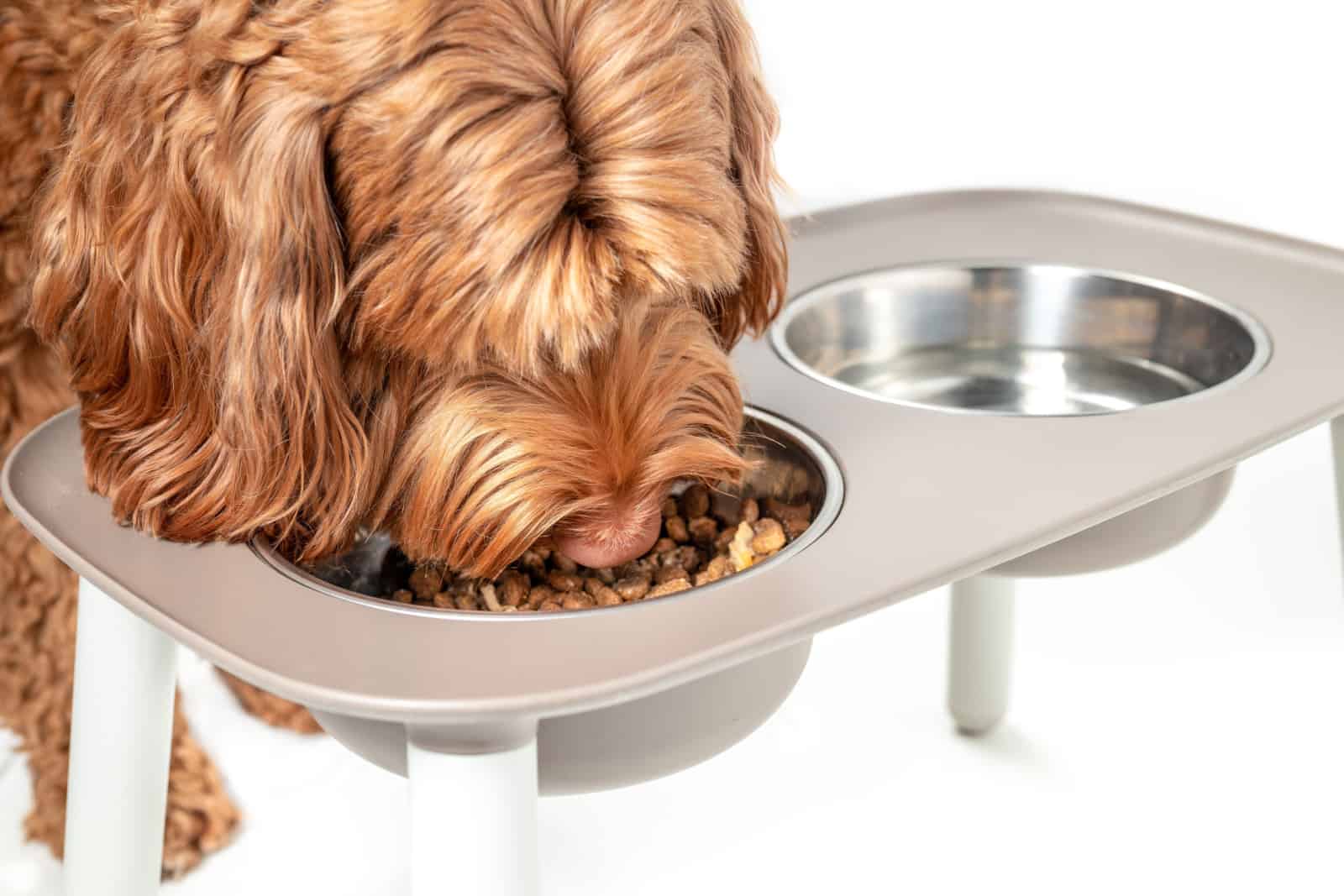Labradoodles are a hybrid made to be the world’s most endearing and family friendly pet, but that doesn’t mean that they don’t need any care, especially in the feeding department, but would a Labradoodle feeding chart really help?
A Labradoodle feeding chart isn’t meant to fix all the problems one may encounter with their Labradoodle puppy in regards to feeding, but it is intended to be a way to at least guide you in the right direction.
For, you see, every dog is born different, even if he’s from the exact same breed as another dog. Plenty of things come into play here that can alter the estimated averages which is something we’ll discuss about a bit later in the article.
On top of all that, the way you train him as well as his general feeding habits, will play a part in forming his ideal diet as well as any potential health issues that may arise later.
So read on to find out more about how big your Labradoodle is going to grow throughout the years and how much he should be fed in most of these periods.
The Labradoodle Feeding Chart
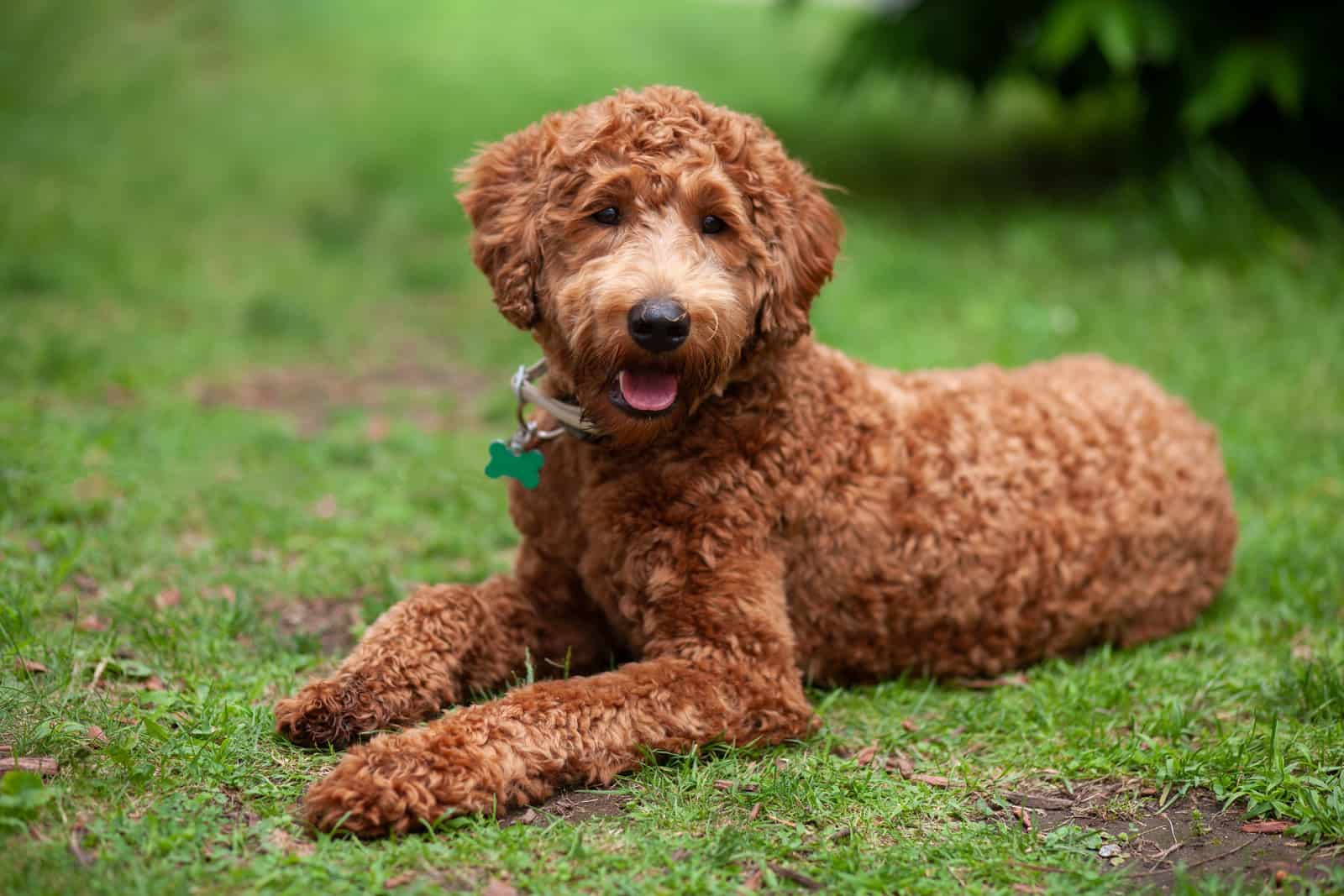
Toy Labradoodle Puppy
[table id=748 /]
Miniature Labradoodle Puppy
[table id=749 /]
Standard Labradoodle Puppy
[table id=750 /]
[table id=751 /]
As you can see here, the main problem isn’t trying to figure out how much a labradoodle should consume daily, as that has some clearly simple input, but what size he is.
Sure, the food dosage doesn’t appear to vary too much, but those ‘small variations’ can, and will add up to a lot as he grows up.
Other than learning about said dosages, it’s also important to be swapping out for age appropriate dry dog food.
Pups have with theirs which is higher in nutrients and protein, after which you’d want to slowly transition over to adult dog food, followed by the senior dog food option down the line.
While not strict, the majority of the Labradoodle’s diet should be high quality dry kibble while mixing in some of the wet food in here and there as a treat, or the raw option, but more on that later.
With the shorter version out of the way, it’s time to look into a proper feeding guide for this lovely breed and to see what the right diet for them should be.
Labradoodle Diet over The Years
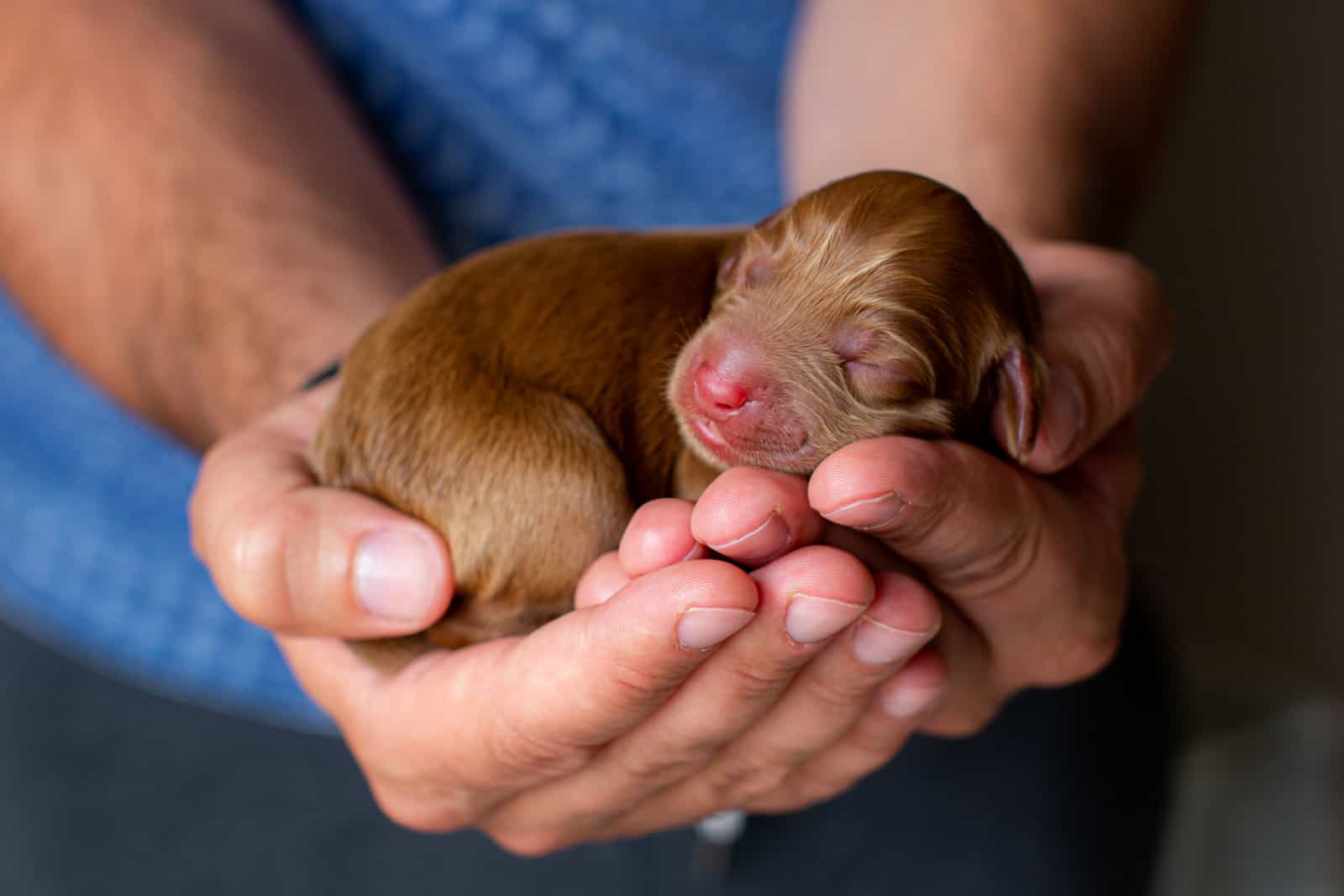
0-2 Weeks Of Age
When he’s just a little pup who was barely born, he won’t be able to move around much, and likely won’t be moving away from his mother either, in which case she’ll be the one handling the feeding part mostly.
Though, you’ll be handling the feeding of the mom which boils down to free feeding in most cases.
Your doggo will be on mother’s milk for this period, and, if, for whatever reason, his mother rejects him, it’s then that you’ll have to step in to simulate his mother’s embrace.
This is usually done through the use of a heating pad and a milk replacement alternative that’ll be bottle fed to simulate sucking on a nipple.
Some breeders cover the pad in something similar to the texture of his mother’s fur and even put a ticking clock under it to simulate the heartbeat, but both of these are optional.
The reason why is so that the pup more readily accepts the given food, to trick him into thinking it came from his mother.
3-4 Weeks Of Age
By this point, the labradoodle puppy would gain a little bit of autonomy and would be waddling around the place, exploring his surroundings and getting better acquainted with them, though he’ll still be almost exclusively feeding off his mother’s milk.
That said, by the tail end of this period, you’re expected to attempt weaning your pupper off of mother’s milk and onto more solid food to make it easier for him to adjust to his new surroundings once he’s rehomed.
Sometimes it won’t work, but you should keep trying every now and then because it needs to be done by week 8 as that’s normally the period in which dogs get handed over to their new owners.
It’s better to attempt swapping him over to dry dog food in smaller batches.
Do it gradually by slowly mixing the dry dog food in with water to help him get used to the new texture and gradually changing the ratios around until it’s predominantly kibble and little to no water.
It’s an old trick that breeders use, one that still works to this day and shows the best results when needing to swap a dog over from one dog food brand to another.
5-6 Weeks Of Age
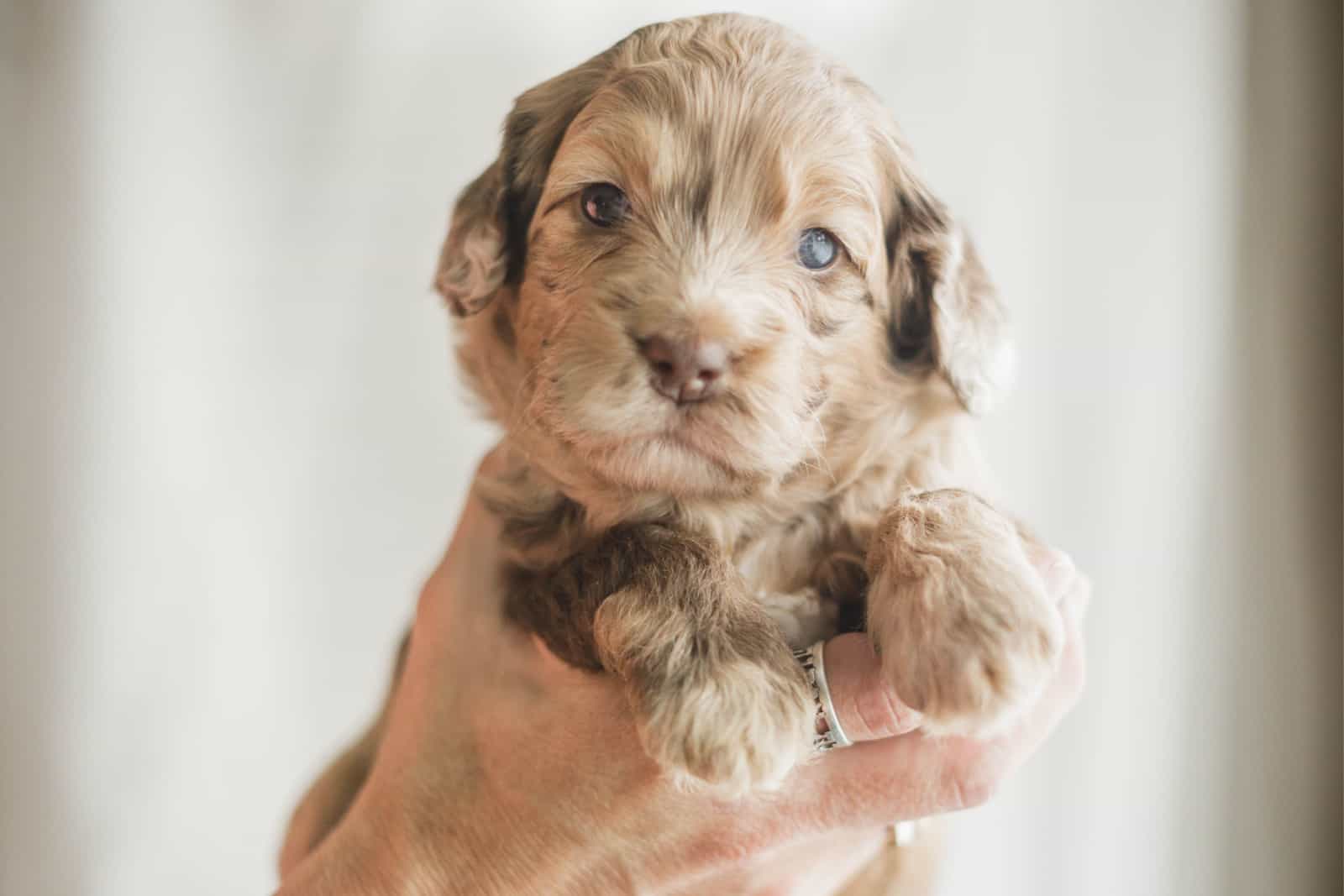
Your dog will still be growing and you’re likely to need to be adjusting the food intake ever so slightly still, though not by much.
There will be a bit of trial and error, sure, but you’ll eventually get to a point where your dog will be enjoying his food without risk of overfeeding or malnourishment.
Just be sure to pay attention to his weight gain over this period and adjust accordingly.
If yours is still stuck on the mother’s milk, now is high time to be more persistent about the fact as it will cause problems for the owners later down the line.
Somewhere nearing the end of week 6 is also when you should be looking into giving him some basic obedience training so he doesn’t cause much trouble for the new owners, or you, depending on who’s getting him.
7-8 Weeks Of Age
This is the final stretch of your puppy’s initial period before he gets rehomed and the very last chance you have to wean him off it and get him onto solid foods as he won’t have access to the former when he gets a new owner.
These initial 2 month periods are mostly the same for almost all dog breeds, so if you’ve seen one, you’ve seen them all.
However, they’re also the most important period in his life as the habits he inherits and learns in these first 8 weeks will determine how easy he is to work with later.
That’s why, aside from making him fully swap to more solid foods by the end of this period if you haven’t already, and getting him started on some basic behavior training is a must.
Sure, Labradoodles are one of the friendliest dogs on the planet, but every dog needs at least some level of training to help root some of that juvenile stubbornness out.
9-10 Weeks Of Age

This is the point where the new dog owner takes over the responsibilities that the breeder had thus far, handling all the Labradoodle’s food, health and training needs.
You’ll still want to consult with the breeder on the methods that he has used so you can continue utilizing them yourself, at least at the start until you get him used to a different method if need be.
If you don’t, you may have your dog end up rejecting the food that you try to give him, leading to feeding problems down the line which can develop into malnutrition or other health problems.
If you want to swap him over to a different type of food, you’ll need to employ that water trick from earlier to help him slowly transition, especially if he’s being fighty about it.
Though, do keep in mind what food you’re putting him on and adjust portion size and amount accordingly to not end up with an over or underweight dog. After all, a balanced diet is the key to a long life.
This is also why I tend to recommend sticking to one type of food, at least during the Labradoodle’s puppy years and sticking to variations once they reach adulthood.
Up To 3 Months Of Age
There isn’t much that changes here, just be sure to continue with his socialization and behavior training in general.
The rest of the pattern remains the same, keeping up with food maintenance and getting your dog checked for any worms, and getting him his vaccinations in order if the breeder hasn’t done so already.
You know, all the aspects that will facilitate the healthy growth of a young dog and prevent the potential risks that can disrupt it, the parasites in particular.
What matters is that he’s kept in shape and that the dog’s weight doesn’t go too much over or under.
4-9 Months Of Age
Still, not much will be happening outside of the random growth spurt and you adjusting your dog’s caloric intake and increasing the daily food amount up to a cup or 1 and 1/4 cups as the period comes to a close.
Stick to high quality food still and leave any homemade diets for later on in life. It’s best to stick to what works unless he has some particularly nasty allergy that would prevent that.
Though be sure to get your dog’s daily exercise in to keep him in shape as his weight can’t be all fat, it has to be a little bit of muscle too.
9-11 Months Of Age
The final period before your dog hits his first year of life and officially reaches adulthood through some vague metric will only see you upping the calorie count on your dog’s diet and maybe reducing the amount of protein you include in his food.
Other than that, it’ll mostly be the same old story, a labradoodle’s growth and overall feeding habits thankfully aren’t too interesting for you to need to devote too much attention to them.
First Year Of Age
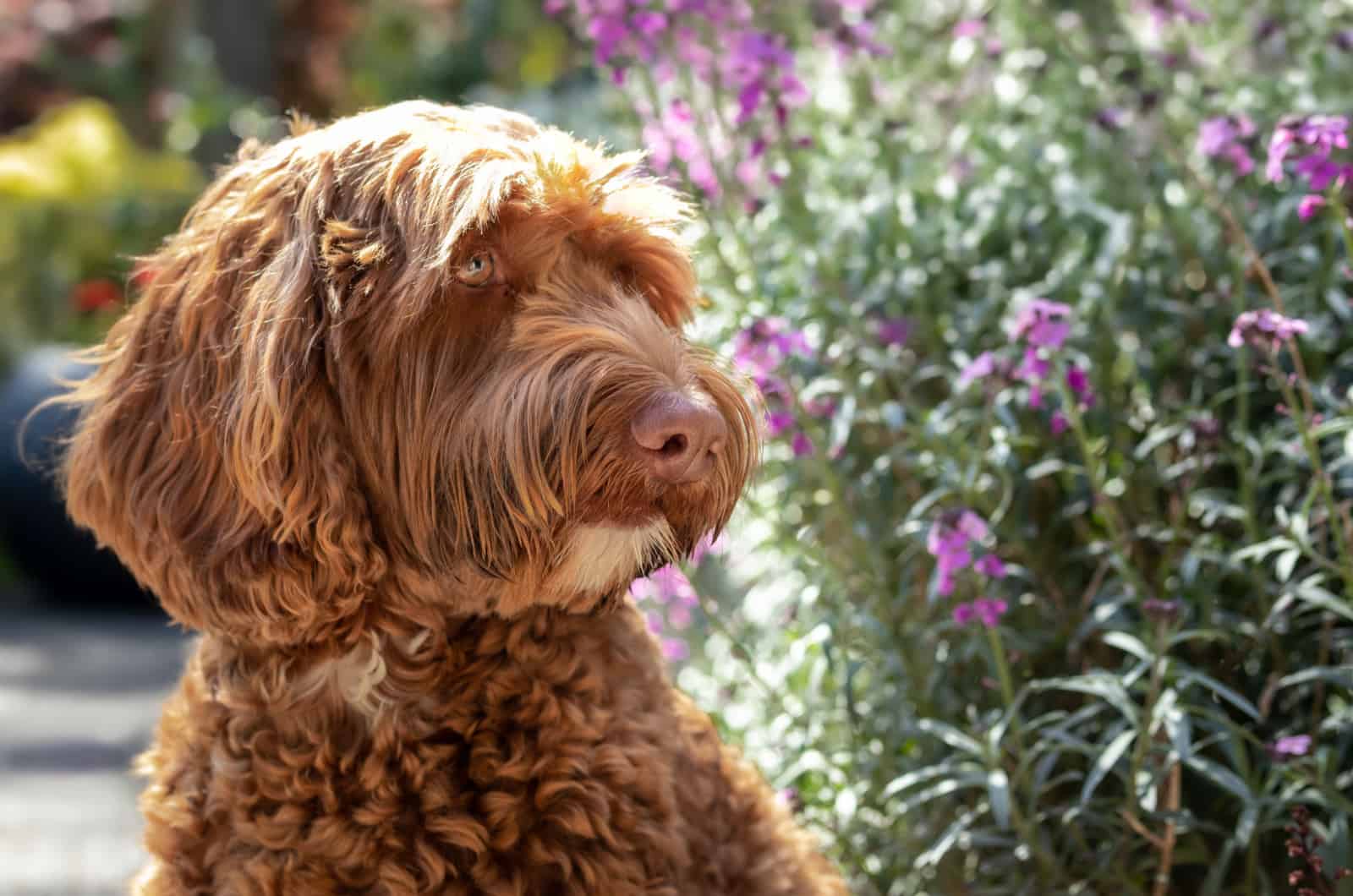
The first year of a Labradoodle’s age officially marks your dog as having become an adult and… not much else honestly.
This does mean that you will have to move him over to dog food that’s more fitting for adults though and that his period of growth has officially finished.
But as for any other duties, they’ll still remain the same, making sure he gets enough exercise, is properly groomed and that he’s loved.
That said, you’re now a bit more free in what you feed him, whether you want to attempt a raw food diet, maybe include a bit of wet food in the mix or an in-between of some semi-moist foods, the world is your oyster in a sense.
Though, be careful with the calories as homemade diets often tend to go out of hand real quick if you don’t pay attention to how much you’re feeding him.
Year 1 To Year 7
As with any other dog, the adult life stage is the part where you and your dog get to enjoy your company the most without any interruptions.
There won’t be any drastic changes to his food regimen nor will you have to make sure he does any particular training or goes on any specific diets barring health problems.
The only thing you’ll have to do is make sure he gets his walks in and his overall exercise as well as his daily food intake which should be down to around 2 portions by now.
The only things that may start changing would happen in the latter half of the period where his metabolism starts to gradually slow down given that he’ll be reaching his senior years and you should start preparing for it accordingly.
This mostly just includes lowering his daily food intake if you notice him starting to pack the pounds on.
Year 7 And Onward
Once year 7 hits, your dog will enter the final period of his life, his senior years.
He’ll still be your friendly and lovable little guy, but he’ll be a bit more slower and docile in accordance to a slower metabolism which doesn’t require him to burn that much energy off.
In most cases, you’ll be able to stick to traditional adult dog food, but in some others, especially if your dog starts having issues with chewing his food, a swap over to the more senior friendly dog food options is recommended.
This is also the period where he’ll be the most prone to some of the health issues that Labradoodles face, so be sure to keep a closer eye on him if you want him to have a longer life expectancy.
It’ll by no means be sudden in most cases, but certain problems like bloat can turn real nasty real fast.
What Major Factors Impact A Labradoodle’s Weight?
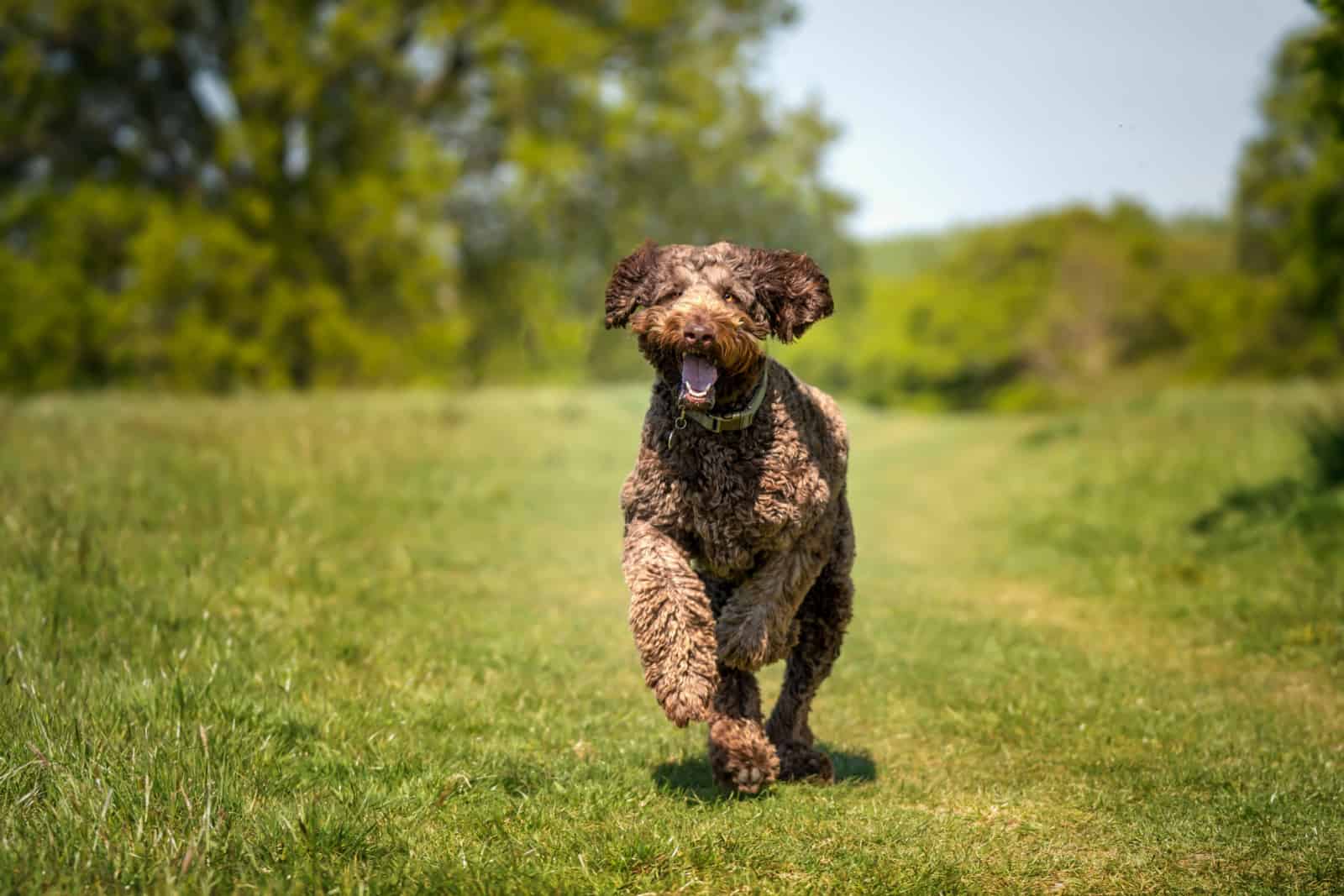
There are a few major contributing factors that will impact a dog’s weight and that aren’t mutually exclusive to any one breed.
Keep in mind that the ones about to be mentioned aren’t the only possible factors and that there are some breed-specific ones to keep in mind.
The main ones are as follows:
1. Genetics
As it is with every dog breed, one of the main factors impacting a Labradoodle’s diet tends to revolve around genetics.
They’re the building blocks of all living things after all and dictate a lot of our features.
In dogs it’s anything from fur growth, overall body growth, the effectiveness of the dog’s metabolism as well as resistance to disease and other health issues.
And, at least for now, it’s something we can’t really do much about aside from treating the conditions that stem from this problem as they come.
Some are treatable, some less so, but all of them require some form of dietary and lifestyle adjustment, especially when it comes to food allergies or sensitive stomachs in general, the times where you have to ditch an entire protein due to a sensitivity.
2. What He Eats
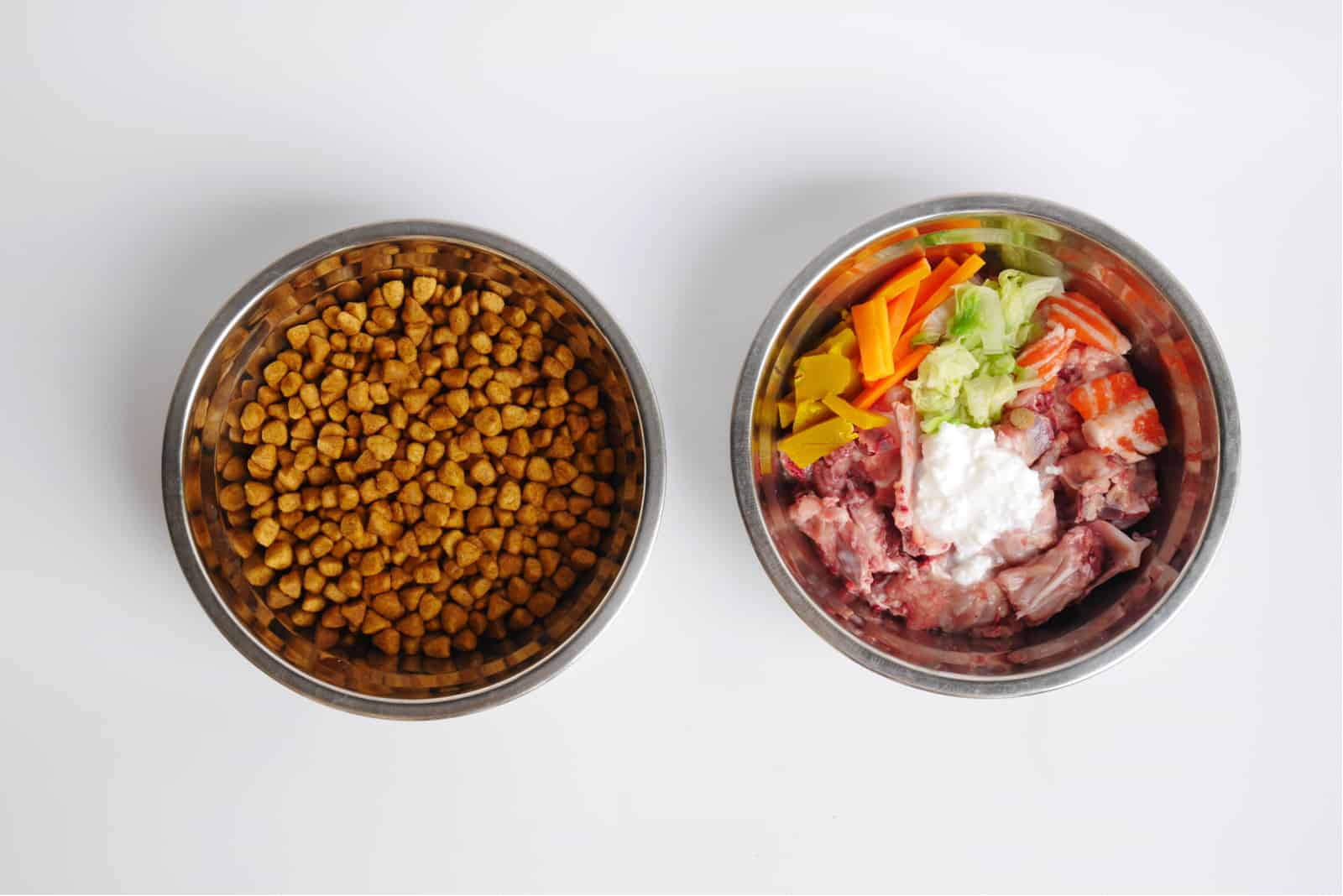
The second major contributing factor is going to be his diet.
It’s easy to generalize the best food to be high quality dry dog food, but that isn’t really going to help too much as there’s plenty of variety to go around.
That’s also why using cups of food as a measure doesn’t really work out all too well given the different amount of caloric content per volume in different food options which is why I keep insisting you adjust depending on your dog’s weight gain or loss.
It’s also why I’ve included daily caloric content in the charts above as well. That said, given the Labradoodle’s size, a pound here or there won’t spell disaster as it may have for smaller breeds, but it’ll still be a good warning sign that you’ll need to act on.
As for what is actually healthy, there are a few things to keep in mind, especially for pups:
Quality Protein
A good protein is the foundation of every piece of dog food and chicken and beef tend to be the best ones to go for with the other alternatives being that of turkey, lamb or fish.
Also, meaty foods are always the better choice for dogs than vegetarian options, especially for Labradoodles given their high energy levels.
Fiber
Something to make all that protein go down smoother is always good to have paired with it, a source of fiber, be it rice, sweet potatoes, peas or similar.
A Healthy Protein To Fat Ratio
You’ll also want around a 30% protein and 15% fat ratio in his food ideally, though as you can see from the charts above, that tends to shift around a little prior to his adulthood and in his senior years.
Plus, you’re allowed to deviate by a few percent, this is just the ideal option.
Though, make sure to avoid fillers as they’re often just empty calories as well as some common allergens like corn, soy and wheat in your dog’s food if he’s having sensitivity issues.
The same goes for anything artificial, especially preservatives as they’re just a detriment to your dog’s health.
Omega 3 Fatty Acids
Other than that, you’ll want to make sure that the food contains omega-3 and 6 fatty acids which help provide a shinier and healthier coat for your dog and improve his overall immune system.
Probiotics
Speaking of which, a healthy batch of probiotics and prebiotic fiber is always welcome as it helps foster the growth of healthy gut bacteria which are responsible for digestion and a more responsive and healthier immune system.
Aside from that, you’ll want a healthy dose of essential vitamins and nutrients in there too, as per usual, to help with overall growth.
DHA and EPA
DHA and EPA are particularly important in puppies as they help develop and maintain their cognitive skills.
Calcium And Phosphorus
Calcium and phosphorus are important too as they help with proper bone and cartilage growth.
Glucosamine And Chondroitin
Aside from those, you also want to include a healthy dose of chondroitin and glucosamine which help maintain bone and joint health, particularly crucial in any medium or large breed dogs given their back problems later on in life.
Of course, that’s the ideal scenario, not everyone is going to be able to find the food that ticks all the boxes, but try getting as close as you can to it.
3. His Level Of Exercise
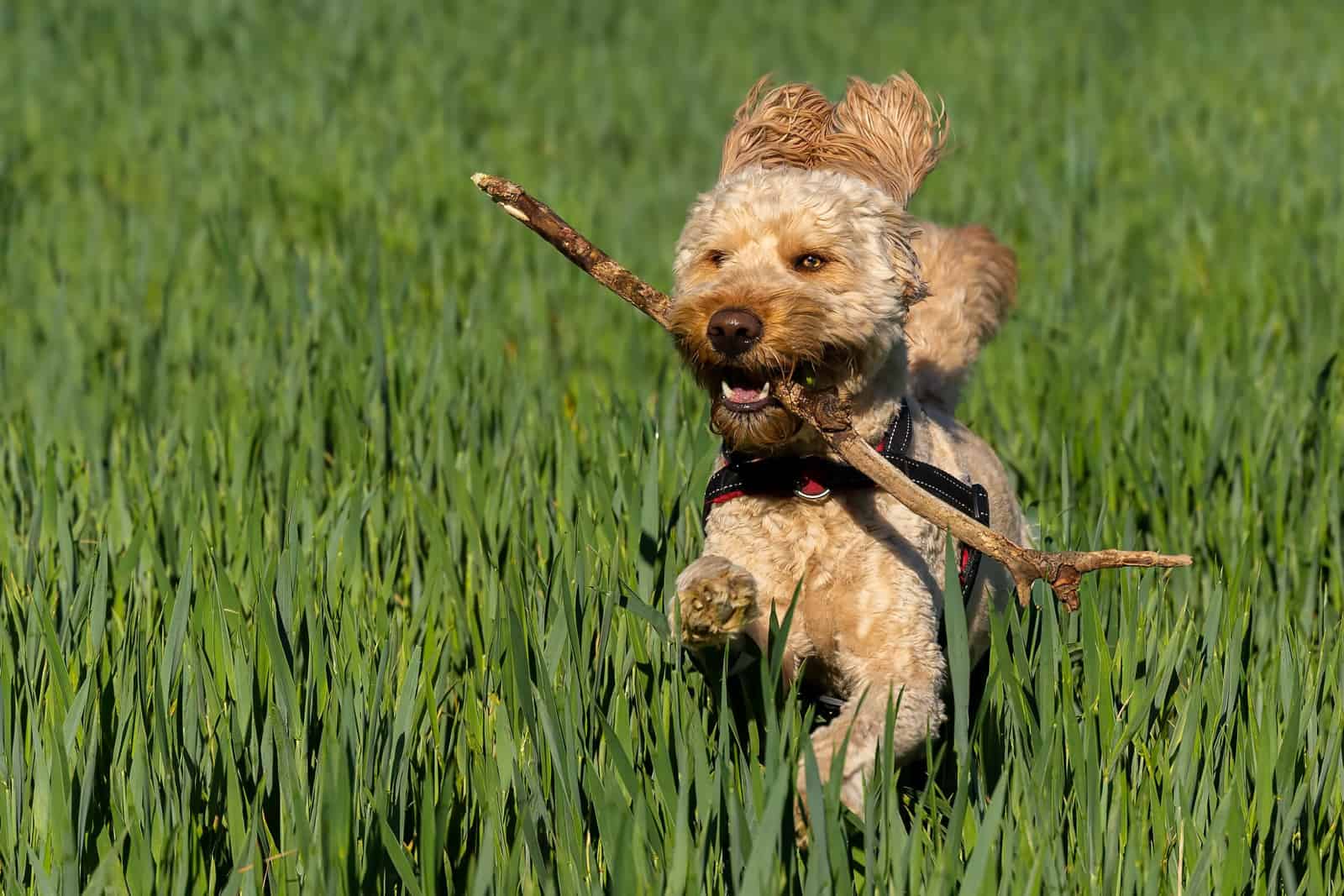
Finally, the last one that’s equally as logical is your dog’s activity level.
It determines how healthy he’s going to be as it’s the best method of building muscle and burning calories and weight along with it.
Labradoodles specifically need about an hour of moderate physical exertion in their day which can be accomplished through a mix of walks and mutual play.
They’re by no means the most demanding dog breeds out there, but they do require a little bit of maintenance and effort from the Labradoodle owner.
Besides, keeping up with exercise will benefit you both while keeping obesity at bay from your pupper.
How Big Does A Labradoodle Get?
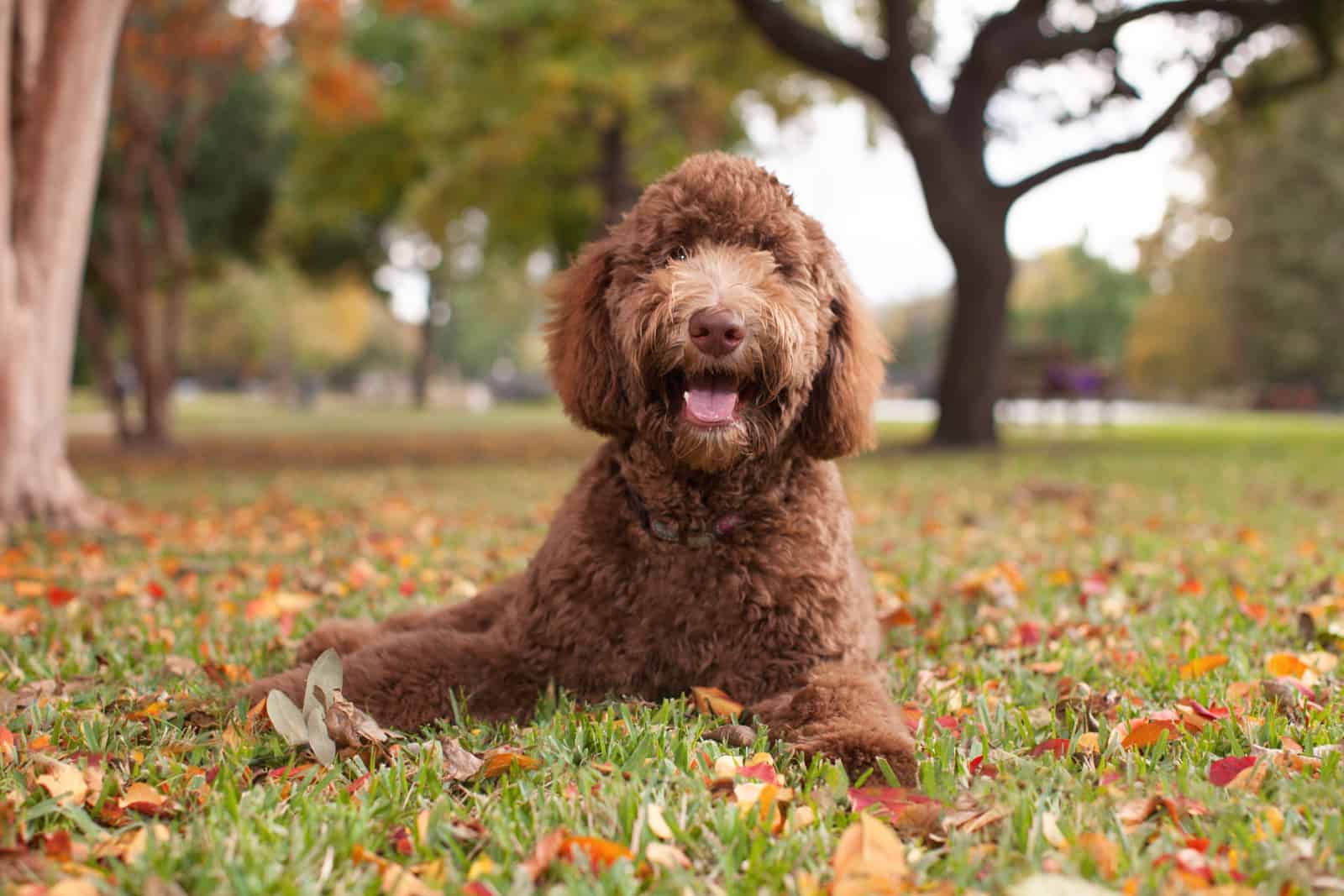
Given the three different sizes of the Labradoodle, there are three different variations to consider, just make sure you know what your Labradoodle is classified as and you should be good.
The toy Labradoodle can reach a height of around 13 to 16 inches with his weight coming in at around 16 pounds on average, give or take a few.
Miniature Labradoodles fall under the same height category of being around 14-15 inches tall on average, but the big difference is their weight which can go up as high as 25 pounds.
Then we have the Standard Labradoodle which reaches an average height of around 23 inches for males and 22 inches for female dog representatives. Not the biggest difference, but it’s still there.
Weight wise, they’re a lot heavier than the mini and toy variants, coming in at around 57-59 pounds on average with lows going all the way down to 50 and highs up to 65 pounds.
RELATED: What Impacts The Labradoodle Growth Chart?
FAQs
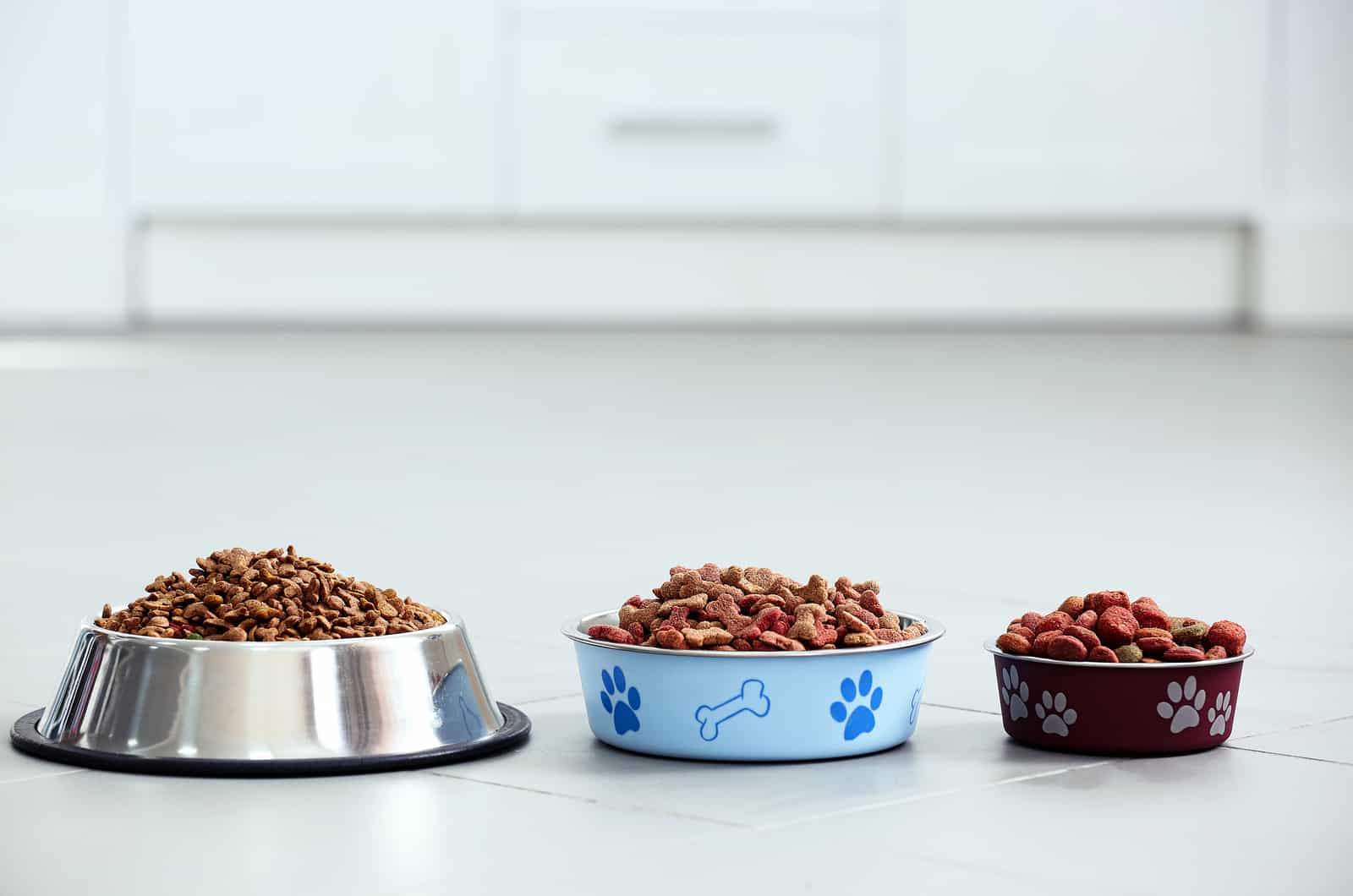
Which Is Better For A Labradoodle’s Diet: Dry Or Wet Dog Food?
A question that’s commonly asked with a relatively simple answer.
While wet dog food is juicier and offers more flavor, it’s not better because of it.
It’s great to serve as a treat every now and then, but not as a consistent diet as it tends to be bad for the dog’s teeth, staining them and affecting their overall quality.
Dry dog food on the other hand usually helps clean teeth given its shape and texture and is often more nutritious.
This isn’t even mentioning the price tags which dry kibble wins out on too given the manufacturing processes that come into play for both sides.
My personal recommendation would be to stick to the dry stuff as the main source of nutrition while dog treats and wet dog food remain only that, treats.
If you want to soften your dog’s food or make the dry stuff into something wetter, you can always use bone broth as a form of sauce to provide it with more flavor on top of all that, and it’s healthy too.
It’s a semi-moist food option which your dog is sure to take to better than the constant stream of dry kibble, and the broth doesn’t really add too many calories but does add nutrients.
But, as with anything homemade, be sure to watch just how much you give to him and adjust accordingly.
What About A Raw Diet?
While there are certain benefits to raw feeding over commercial dog food, such as giving you more customizability with what ingredients you’d want to put in and making sure it’s all fresh, I personally tend to stray away from them.
There’s the obvious factors of it taking a lot more time to prepare and it being more expensive, but raw food diets can also be potential health hazards, especially with things like barely fresh chicken.
Sure, our meat is kept to a higher standard than most countries’, but uncooked meat still poses a potential risk of parasites finding their way into your dog’s body or some other disease hurting his well being.
Everyone knows how much of a nightmare it can be to have a house dog have a particularly loose stool or just outright diarrhea and having to clean that mess up.
On top of all that, it also depends on how much you can actually find as dogs on raw diets often end up not having their nutritional needs met unless you’re using supplements to make up for it.
In any case, my personal take is that I wouldn’t recommend it, but if you have the money for it and can manage it, a raw meat diet can be a decent alternative, if you make sure that the meat is properly cooked first.
When Should I Swap From Puppy Food To Adult Food?
The swap usually happens in the last few months of your dog’s puppyhood, at around the time when he stops growing which tends to be month 8 and onward for the Labrador and Poodle hybrid.
Use the water trick mentioned before with the gradual addition of adult kibble into his puppy one to allow both him and his digestive system to adjust to the change slowly rather than all at once and risking an upset stomach.
You can use the same method later down the line when he turns to his senior years, or if you’re looking to get him onto some new food in general.
What Are Some Common Labradoodle Health Issues To Be On The Lookout For?
Despite the existence of hybrid vigor in first generation Labradoodle hybrids which makes them relatively healthy dogs, there are still a few health issues to be on the lookout for.
Your dog should be on the safe side, but on the off chance that the issues have managed to cross from the parent breed over to your pup, it’s worth being careful.
There are a few standard issues which every pet parent should be concerned about as well too, and here are some of the more common ones:
Hip And Elbow Dysplasia
While not as big a risk for the toy and miniature Labradoodles as it is for the standard ones or some large dogs, hip and elbow dysplasia can happen to any dog.
It’s a condition where the elbow or hip joint no longer fits properly into the socket and can pop out.
This is usually caused by friction wear over time and isn’t something that can be fully fixed with current day technology.
It can, however, be prevented as long as you maintain your dog’s body weight within the ideal parameters as being obese contributes to an increased risk of dysplasia.
Bloat
The second on the list is bloat, a particularly heinous issue that’s often brought upon by either overeating or eating too quickly in dogs.
A problem that occurs when the stomach distends to fit in a larger amount of food only to twist around itself when retracting back, trapping the contents of the stomach inside it as well as cutting off blood flow to neighboring organs.
As you can tell, this can get real bad, real fast, which is why your dog is going to need immediate veterinary help in reversing the problem.
A good preventative measure is to teach your dog how to pace himself while eating to minimize the chances of this issue happening in the first place.
Parasites
One of the most annoying problems to deal with which is thankfully curable, are parasites.
While not really a disease or any particular condition caused by the body, it is caused by nasty parasitic worms of which the most popular ones tend to be hookworms, ringworms and tapeworms.
They like attaching themselves on the inside of your dog’s digestive tract, entering through contaminated or raw and uncooked food and then end up siphoning the healthy nutrients from your canine companion.
If you see him acting lethargic, having a lack of energy or having a sudden and drastic loss in weight, take a stool sample to the vet to see if he’s infested, then take him in for a deworming procedure.
This is something you need to be particularly wary of during his puppy period as nutrient deficiency caused by these parasites can end up having a real negative effect on his overall growth and can drastically reduce his lifespan.
Other Problems
Aside from digestion related problems, Labradoodles can contract minor issues like various skin and ear infections, as well as some serious ones like epilepsy which can be particularly nasty to deal with in dogs.
One issue in particular is Addison’s disease, one where the body can’t regulate stress properly due to the irregularity in controlling cortisol levels in the body which can lead to a whole load of issues like loose stools, excessive urination, increased levels of thirst and high heart rates.
Essentially, any symptom you’d be able to attribute to excess levels of stress.
Thankfully, the disease is rather rare and mostly affects Australian Labradoodles, but frequent intermingling can see it transfer to other members of the breed.
What Else Can Affect A Labradoodle’s Weight?
Aside from the three mentioned above, there is one other factor that can affect your dog’s dietary needs and why most feeding charts are seen as interpretations rather than fact and that is the temperature.
The feeding chart applies to normal, room temperature conditions, but both hot and cold environments can increase or decrease the necessary calorie amount.
The hot environments can lead to a loss of appetite which can lead to your dog dropping a pound or two and, in order to remedy that, I suggest giving him lighter portions or lighter food in general so he doesn’t get winded as easily.
On the other hand, a cold environment may lead to your dog eating more food so his body can have the energy reserves to stay warm.
While it won’t be on the same level as a hibernating bear would need, be sure to give him a bit of a caloric boost here and there.
That’s why winter can be the ideal time to treat your Doodle to some of the wet stuff.
In Conclusion
In order to ensure healthy growth for your doodle pup, it’s always recommended that one follows a Labradoodle feeding chart.
While it’s not meant to be a strict plan, but rather a set of guidelines, a foundation from which you can further build your pet’s personal feeding plan which will constantly be shifting.
After all, every dog is a unique creature on their own, be they a rescue, a stray or taken care of by a certified breeder, with their own unique needs that will need to be catered to.
Regardless of whether you’re having trouble keeping his weight at a healthy level or not, I suggest consulting with your local vet or pet nutrition expert on the matter to have an easier time curating the ideal diet for your canine companion.
Though, I’m sure your pup is in the right hands, a little bit of assistance can only help improve both your lives. Until next time, pet parents.
RELATED LINKS:
